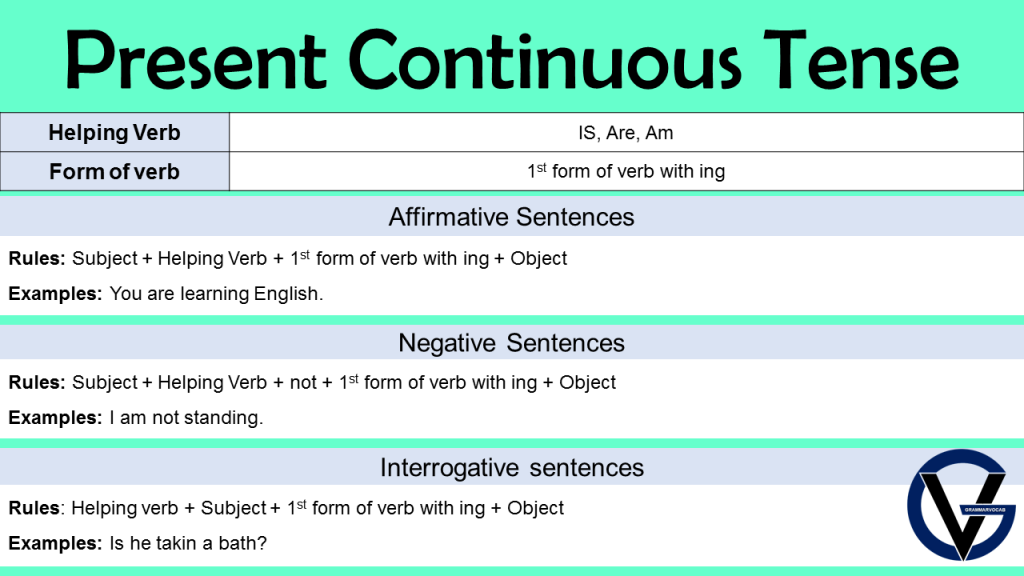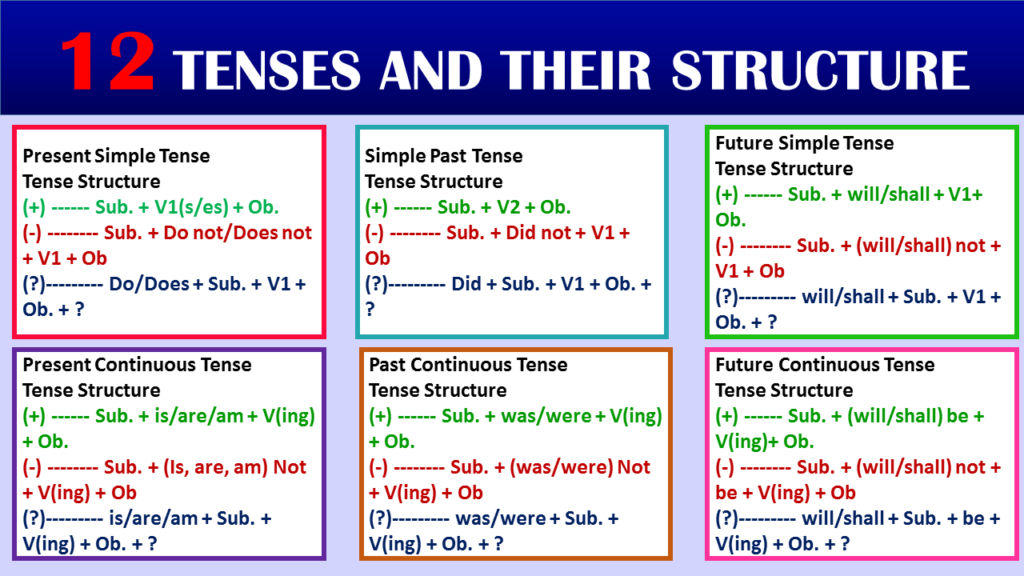English is a versatile language with various tenses that help convey different meanings and time frames. One of these tenses is the “present continuous” tense, also known as the “present progressive” tense. It allows us to describe actions and events that are happening right now, at the moment of speaking, or actions and events that are ongoing over a specific period of time in the present. In this comprehensive guide, we will delve into the rules and provide numerous examples of the present continuous tense in English.
Structure of Present Continuous Tense
The basic structure of the Present Continuous tense is as follows:
The basic structure of the Present Continuous tense is as follows:
Affirmative Sentences:
-
- Subject + am/is/are + verb (base form + -ing) + object/complement
Negative Sentences:
-
- Subject + am not/is not/are not (aren’t) + verb (base form + -ing) + object/complement
Interrogative Sentences:
-
- Am/Is/Are + subject + verb (base form + -ing) + object/complement?
Present Continuous Affirmative Sentence
- Soon after the subject, Put the helping verb is, am, are according to the subject.
- Then secondly, use the continuous form of a verb with ‘ing’.
- With he, she, it, or singular noun use ‘is’ and with they, we, and you, use the helping verb, ‘are’. Use ‘am’ with the subject ‘I’.
Rules: Subject + Helping verb + Basic form of verb with ing + object.
Formula:
| Subject + | Helping verb + | basic form of verb +ing + | Object |
| You | are | knitting | sweater |
| Singular Noun | is | knitting | sweater |
| They | are | knitting | sweater |
| We | are | knitting | sweater |
| I | am | knitting | sweater |
| It | is | knitting | sweater |
| She | is | knitting | sweater |
| He | is | knitting | sweater |
Present Continuous Examples (Affirmative sentences)
- You are learning English.
- Birds are chirping in the air.
- Children are playing in the garden
- Jan is swimming.
- We are watching the news on T.V.
- He is playing hockey.
- I am playing hockey.
- We are playing hockey.
- He is writing a letter.
- He is impressing them.
- She is knitting the sweater.
- They are weaving the blanket.

Present Continuous Negative Sentences
In negative sentences of this tense, put ‘not’ after the suitable helping verb and then the first form of verb with ing.
Rules: Subject + Helping verb + not + Basic form of verb with ing + object.
Formula:
| Subject + | Helping verb + | not + | Basic form of verb + ing + | Object |
| You | are | not | knitting | sweater |
| Singular Noun | is | not | knitting | sweater |
| They | are | not | knitting | sweater |
| We | are | not | knitting | sweater |
| I | am | not | knitting | sweater |
| It | is | not | knitting | sweater |
| She | is | not | knitting | sweater |
| He | is | not | knitting | sweater |
Present Continuous Examples (Negative sentences)
- I am not standing.
- Jan is not reading a book.
- Jan is not doing the homework.
- Tailor is not sewing the clothes.
- Ali is not plucking the flower in the garden.
- Boys are not plucking flowers.
- I am not teasing them.
- I am not diverting the children.
- I am not boiling the eggs.
- The carpenters are not making the furniture.

Interrogative sentences
- In these sentences put the helping verb is, am, are at the start of the sentence before the subject.
- Then the first form of the verb with ing is used. At the end of the statement, use the interrogative mark (?).
Rules: Helping verb + Subject + Basic form of verb with ing + object.
Formula:
| Helping verb | Subject | Basic form of verb+ing | Object |
| You | are | knitting | sweater |
| Singular Noun | is | knitting | sweater |
| They | are | knitting | sweater |
| We | are | knitting | sweater |
| I | am | knitting | sweater |
| It | is | knitting | sweater |
| She | is | knitting | sweater |
| He | is | knitting | sweater |
Present Continuous Examples (Interrogative sentence)
- Are you going to school regularly?
- Are the children playing football?
- Is he taking a bath?
- Are hens laying eggs?
- Is he knocking at the door?
- Are they convincing him?
- Am I diverting the children?
- Are they teasing the servant?
- Am I watching the plants?
- Is Ali not lulling the child?
- Are we sowing the rice?
Usage of the Present Continuous Tense
The present continuous tense is used to describe actions and situations that are occurring at the moment of speaking or are ongoing in the present. Here are the primary situations in which this tense is used:
Actions Happening Now: It is used to describe actions or events taking place at the present moment.
-
- I am writing an article.
- She is talking on the phone.
Temporary Situations: The present continuous tense can also describe temporary situations or conditions.
-
- He is living in London for the summer.
- They are staying with us until their house is ready.
Future Plans: In some cases, it can be used to describe future plans or arrangements when these plans are firmly decided and scheduled.
-
- I am meeting John tomorrow.
- She is flying to Paris next week.
Annoyance or Complaints: The present continuous tense can express annoyance or irritation about a repeated action.
-
- He is always interrupting me during meetings.
- She is constantly checking her phone.
Now that we have a clear understanding of the structure and usage of the present continuous tense.
Must Try:
Present Perfect Tense with Example
Present Perfect Continuous Rules
Past Indefinite Tense
Images





